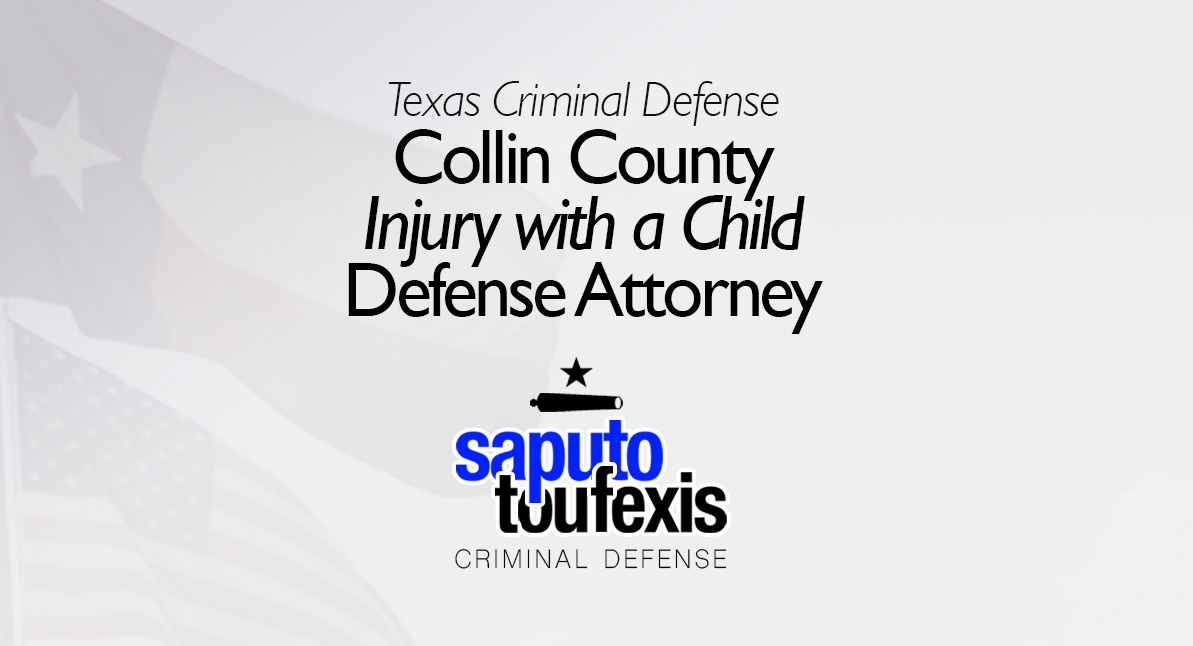Are You Looking for the Best Collin County Injury to a Child Attorney?
If you’re looking for the best Collin County Injury to a Child attorney, then Paul Saputo and Nick Toufexis want to represent you. Award-winning attorneys Paul Saputo and Nick Toufexis expertly bring the firm’s full resources to bear in Collin County Injury to a Child cases.
Collin County Injury to a Child Attorney FAQs
- How do I get an Injury to a Child charge dropped in Collin County, Texas?
- What does an Injury to a Child charge really mean?
- How do Collin County Injury to a Child defense lawyers beat an Injury to a Child case?
- How much does it cost to fight a Collin County Injury to a Child case?
- What happens at a Collin County arraignment?
- How can you modify your Collin County bond conditions after an Injury to a Child arrest?
- What is the most common sentence for an Injury to a Child charge in Collin County?
- Other Must Know FAQs About These Cases
The Saputo Toufexis attorneys thrive on serving individuals who are dedicated to achieving the best outcomes. Our clients recognize the value of our legal expertise and want to hire the top attorneys in the field.
We’re not just Collin County Injury to a Child lawyers. We are warriors fighting unjust and corrupt government prosecutions with a history of success and a reputation for tenacity, courage and legal ingenuity.
In addition to our notable high-profile victories, our history of success also includes inconspicuous representation of numerous high-profile clients. Indeed, many of our biggest wins involved disposing of these cases quietly and out of the sight of the public. When you are facing a criminal prosecution, you have a lot to worry about. Accordingly, our Collin County Injury to a Child attorney representation does not stop at the McKinney courthouse door.
Our experienced team works tirelessly to build a strong defense and protect our clients’ rights. We can provide you with an effective defense strategy for your Collin County Endangering a Child case. Call us or book an appointment online today.
Contact a Collin County
Injury to a Child Lawyer
When you are ready to fight your case with us, schedule online or call us at (888) 239-9305 to book a free, confidential consultation.
Choosing The Right Collin County Injury to a Child Lawyer Can Make A Huge Difference In Your Case Result
Why would you hire a former prosecutor? Surprisingly, some people believe that former prosecutors provide some special advantage. However, many of these attorneys seem to quickly push clients to a plea deal. If you really want someone who will fight for you or your loved one, get an attorney who has dedicated their life to protecting the accused.
At Saputo Toufexis | Criminal Defense, we are defense lawyers, first and foremost. We stake our reputation on bringing the fight to the state. We have never worked for the government and never will. Learn more about our team, awards, and some of our victories.
Do you need a Collin County Injury to a Child attorney? Call us today at (888) 239-9305 to discuss legal representation.
How do I get an Injury to a Child charge dropped in Collin County, Texas?
In order to get an Injury to a Child charge dropped in Collin County, you must convince the state that they cannot prove at least one of the elements of the offense as it is defined in Penal Code §22.04.[1] Our lawyers are experts in the Texas law regarding Injury to a Child, and we leverage our legal knowledge to mount successful defenses to government prosecutions.
Thoroughly understanding both the Injury to a Child statute and related case law contributes to effectively defending you in court. As part of our practice, we publish and regularly update a statutory resource guide covering all Texas Penal Code crimes. We analyze the Injury to a Child statute in detail on the Injury to a Child offense page. We also maintain our expertise by keeping up with the latest case law affecting Injury to a Child cases in Collin County.
One such case is Strickland v. State.
Strickland v. State
In Strickland v. State, the Court of Appeals of Texas Fifth District Dallas on January 4, 2001, affirmed the conviction of Samuel Jake Strickland for Injury to a Child in Collin County. Strickland was accused of injecting heroin into a 14-year-old girl, leading to his conviction and an eight-year sentence in the state penitentiary. On appeal, Strickland raised six points of error, including challenges to the sufficiency of evidence proving he injected the victim with heroin, the recklessness of his conduct, the trial court’s affirmative finding that heroin was used as a deadly weapon, lack of notice of the State’s intent to seek a deadly weapon finding, and the admission of his written confessions.
The appellate court found the evidence both legally and factually sufficient to support the conviction, holding that Strickland’s own confessions, testimony from witnesses, and expert opinions adequately demonstrated he injected the girl with heroin, acting recklessly given the known dangers of the drug. The court also upheld the trial court’s designation of heroin as a deadly weapon and found that Strickland had been properly warned of his rights before giving written statements. The court determined that any objections to the expert testimony on who could be a perpetrator were harmless and did not influence the jury’s verdict, thereby dismissing Strickland’s concerns regarding the relevance and prejudicial impact of the expert’s testimony.
This decision underscored the importance of direct confessions and expert testimony in establishing the elements of the offense, including the nature of the substance involved and the recklessness of the defendant’s conduct. The case also highlighted procedural aspects regarding the admissibility of confessions and the requirements for notifying defendants about the charges against them and the evidence presented in court. The affirmation of the trial court’s judgment reflects the appellate court’s deference to the trial court’s findings on matters of witness credibility and the sufficiency of evidence.
What does an Injury to a Child charge really mean?
The Texas Penal Code defines the charge of Injury to a Child as follows:
(a) A person commits an offense if he intentionally, knowingly, recklessly, or with criminal negligence, by act or intentionally, knowingly, or recklessly by omission, causes to a child, elderly individual, or disabled individual:
(1) serious bodily injury;
(2) serious mental deficiency, impairment, or injury; or
(3) bodily injury.
(a-1) A person commits an offense if the person is an owner, operator, or employee of a group home, nursing facility, assisted living facility, boarding home facility, intermediate care facility for persons with an intellectual or developmental disability, or other institutional care facility and the person intentionally, knowingly, recklessly, or with criminal negligence by omission causes to a child, elderly individual, or disabled individual who is a resident of that group home or facility:
(1) serious bodily injury;
(2) serious mental deficiency, impairment, or injury; or
(3) bodily injury.
Law Enforcement Agencies in Collin County that Make Injury to a Child Arrests
Peace officers with the Texas Department of Public Safety, constable offices, and municipal police departments can make arrests for violations of Injury to a Child in Collin County. Law enforcement agencies in Collin County that most typically make Injury to a Child arrests include:
- The Collin County Sheriff’s Office handles Injury to a Child enforcement throughout Dallas County.
- McKinney Police Department – Serving the city of McKinney, the police department provides Injury to a Child enforcement within the city limits.
- Plano Police Department – This municipal police department serves the city of Plano by investigating Injury to a Child cases within the city’s limits.
- Frisco Police Department
- Allen Police Department
- Murphy Police Department
- Wylie Police Department
- Anna Police Department
- Princeton Police Department
- Farmersville Police Department
- Melissa Police Department
How do Collin County Injury to a Child defense lawyers beat an Injury to a Child case?
To beat an Injury to a Child charge in Collin County, Texas, you will inevitably have to face both the complaining witness and the police officers who investigate the case. We will prepare a thorough and aggressive defense that takes into account all of the facts and circumstances, and we can use all of the resources that are available to the state–and even resources that the state never thought to use.
Even if you believe you cannot beat the case, as your Collin County Injury to a Child attorney, we will look for every avenue to help you. If you want to plead guilty, we must still fight to protect your rights. We want to ensure that the case does not ruin your life. Sometimes the defense strategy requires us to get the best possible result short of a not guilty verdict.
Collin County Injury to a Child Attorney Case Defense Strategy
Getting the best result in a Collin County Injury to a Child case requires being fully prepared for all hearings and court settings – not just trials. Accordingly, when you hire us as your Collin County Injury to a Child attorney, we prepare early and thoroughly. As soon as we get on a case, the Collin County District Attorney’s Office knows that we are getting ready for trial. They know that we are going for an outright acquittal.
But the preparation often starts even before the case begins. From the moment that the police initiate an investigation or make an arrest, we have work to do. If you want to win your case, then we must do our own investigation. The state has police and investigators of their own working for them to gather evidence to support their case. We can’t afford to let their evidence stand uncontroverted.
As a client, you will benefit from the investigative resources of the entire law firm. We have a team of dedicated professionals, including paralegals, investigators, and forensic experts. Our attorneys utilize our team’s extensive investigative experience to perform the ground work that makes our cases strong.
How much does it cost to fight a Collin County, Texas, Injury to a Child case?
Attorney’s fees for a Injury to a Child charge typically range from $9,000 to $50,000 in Collin County, Texas. You can expect to pay higher attorney fees for more complex cases. Some Collin County Injury to a Child lawyers may charge much more. But exercise caution when encountering attorneys who offer unexpectedly low fees.
In addition, many lawyers charge extra fees for trial. If you hire an attorney from outside Collin County, sometimes travel fees may apply.
What to Do if Falsely Accused of Injury to a Child in Collin County
Even if someone has falsely accused you of Injury to a Child, you should nevertheless still always take this charge very seriously. You may think that the state may “drop charges” against you because you are innocent. But absent effective advocacy by a lawyer, the state will often take the case to trial and let the jury decide.
If the state has charged you with Injury to a Child, or if you are under investigation for the offense, then you should book an appointment or call us as soon as possible to speak with one of our Collin County Injury to a Child attorneys.
How can you modify your Collin County bond conditions after an Injury to a Child arrest?
Texas judges have broad power to set bail and bond conditions. However, sometimes judges impose overly harsh bond conditions and astronomically high bail. To modify the conditions of bond or lower bail, you will need to file a motion in court and schedule a hearing. The judge will ultimately make the final decision. To get the best result, you should hire an attorney to help.
Practically speaking, if the police in Collin County have arrested you for Injury to a Child, then the judge will typically impose a “no contact with the victim” bond condition. Frequently, judges will also impose a “no contact with minors” condition for these cases as well. Clients often hire us to try to get these conditions removed. If you want to remove a no contact condition, then please book a consultation with us, and we will discuss what we can do for you.
What happens at a Collin County arraignment?
At your arraignment, a Collin County judge will hear your plea of not guilty. In Collin County, you may not have an attorney at your initial arraignment. However, the court will not hear a guilty plea prior to your being represented by counsel. In addition, the court may also set bail and bond conditions if you have not already received them.
If the police have arrested you for Injury to a Child, then Texas Code of Criminal Procedure §17.40 requires Collin County judges to “impose any reasonable condition of bond related to the safety of a victim of the alleged offense or to the safety of the community” to secure your attendance at trial. If the state alleges that you violated those bond conditions, then the Collin County Sheriff’s Office can immediately return you to custody. Accordingly, judges have very broad power in determining bail conditions and bond amounts.
What is the most common sentence for Collin County Injury to a Child charge in Collin County?
The Texas Penal code outlines the range of punishment for all Injury to a Child convictions across the state. The Texas Penal Code classifies Injury to a Child as a felony ranging from a state jail felony to a first degree felony.
However, the actual punishment you receive will vary significantly based on a number of circumstances, including your prior criminal history and the circumstances of the offense. With this in mind, you can learn about the penalties that apply to all Texas convictions for Injury to a Child here. Otherwise, to learn more about what kind of punishment is typical in Collin County Injury to a Child cases, call us to schedule a consultation or book online.
Furthermore, all good Collin County Injury to a Child attorneys will also advise you on the collateral consequences of a Injury to a Child conviction. Collateral consequences are penalties derived from convictions that are not necessarily part of the penal code punishment.
Are you under investigation for Injury to a Child? Should you cooperate with the police investigation?
We have assisted our clients through many difficult police interrogations. Although we do not typically recommend consenting to a police interrogation or interview, there are circumstances when we consider it. However, you should never do a police interview without your Collin County Injury to a Child lawyer present.
When police bring you in for an interview, they already believe that you committed the offense. Accordingly, this belief will inform their interpretation of your answers. Generally, when people believe something, they will only see things that confirm their belief. This is called confirmation bias, and this is what leads to police charging innocent people with crimes.
An arrest for Injury to a Child can drastically change your life, even if a court dismisses your case. Do not hesitate to contact us immediately if you are under investigation.
In addition, remember that people do not usually communicate perfectly clearly under intense pressure. The extreme stress of a police interview can cause you to say something that police then misinterpret. And even the way you look during the interview significantly impacts the police decision to arrest you. For all of these reasons, we carefully consider the decision to interview because it will have a huge impact on the ultimate outcome of your case.
In some cases, we have communicated directly with law enforcement authorities on behalf of our clients instead of consenting to a direct interrogation. As your Collin County Injury to a Child attorney, we can assist you in these difficult circumstances.
Reviews
Real client testimonial:
The most outstanding Law Firm in the DFW area Paul & Nick are top notch in handling legal matters! If you require legal assistance there is only one law firm in the DFW area to choose and it’s Saputo Toufexis! A huge Thank You to the entire staff!
– Real client review posted on the Saputo Toufexis Google Profile.
See more client reviews and testimonials here.
Legal References:













